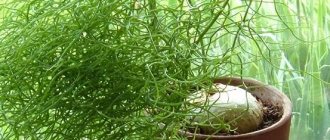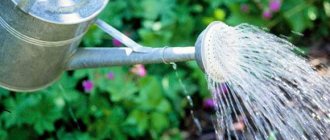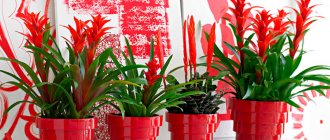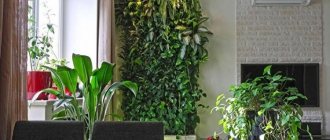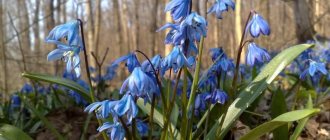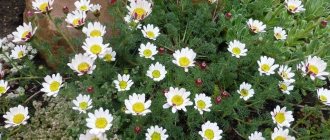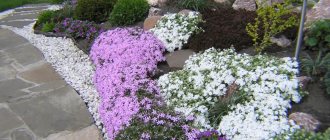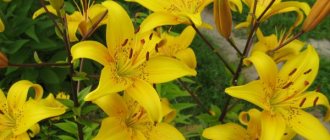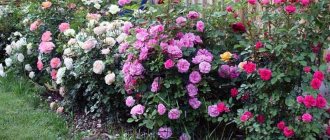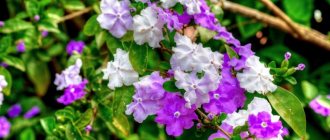Aptenia plant literally translates as “wingless” or a flower that begins to open its petals at noon. This succulent belongs to the Aizaceae family .
Aptenia has large fleshy shoots, its leaves are shaped like a heart. The inflorescences are small, pink, red or blue, formed on the side shoots .
What's interesting about aptenia?
Under natural conditions, aptenia is a subshrub that grows up to half a meter. The plant has fleshy shoots and oval leaves. It looks especially impressive during flowering, when it produces small, bright purple flowers. After this period ends, fruits with capsules form in their place. In each of them one large seed with a rough shell ripens.
In indoor conditions, aptenia is grown as an hanging plant. Since the flower is easy to care for, it is suitable not only for professionals, but also for novice gardeners.
Aptenia: types and varieties for growing at home
Only 3 types of apthenia are cultivated.
Cordifolia
An evergreen perennial that grows quickly. Its shoots are creeping, splayed, and greenish-gray in color. In cross-section they are oval or tetrahedral. The leaves are fleshy, lanceolate-heart-shaped, up to 2.5 cm long. The flowers are small, solitary, and come in crimson, purple or pinkish-lilac color.
Variegated
It is distinguished by its reduced size of leaves, shoots, and flowers. The leaves are spotted due to the presence of mutant cells in the vegetative organs. They do not participate in photosynthesis, resulting in spotting. The spots come in different sizes and shapes. This species is considered a chimera, which makes it difficult to care for.
Lanceolate
A plant with long hanging shoots up to 1.5 m long. The leaves are elongated, with long lateral shoots. The flowers are small, lilac or soft pink, bloom in April.
Views from photos
According to various sources, there are 4 types of apthenia. The following are suitable for growing indoors.
- Apthenia cordifolia.
The plant has small multi-petaled flowers, colored pinkish-lilac, crimson or deep purple. The flowering period of this species begins in mid-spring and ends in summer.
- Apthenia variegated.
The shoots and leaves of this species are smaller than those of Apthenia cordifolia. There is a light edging along the edges of the leaf plates. The flowers of the variegated variety are a rich scarlet hue.
- Apthenia lanceolate.
The flowers of this species are small, lilac or pinkish in color. The flowering period of Apthenia lanceolate is quite long - from April to October.
Flowering time
Flowering of the crop is observed throughout the warm period of the year from April to the end of August.
Inflorescences appear at lunchtime, but the flowers do not always open fully ; this requires good, bright lighting.
Important! In winter, the plant goes into a dormant state to gain strength.
Planting: requirements for pot and soil
It is recommended to plant aptenia in a small wide pot with drainage holes. A layer of expanded clay should be laid out at the bottom of the selected container, and the remaining space should be filled with a soil mixture consisting of the following components:
- 1 part each of turf and leaf soil;
- 1 part humus;
- 2 parts sand.
You can purchase a ready-made mixture at a flower shop. For aptenia, standard soil for succulents is suitable.
Home care
even an inexperienced gardener can take care of apthenia at home .
The plant develops well in illuminated places, the surface of the leaves does not suffer from constant exposure to sunlight.
Lighting
Aptenia is considered a light-loving crop; when growing this plant at home, pots should be placed on the south-eastern or south-western window sills of the room .
In summer, at noon, crops are shaded or the temperature is reduced by ventilating the room. When there is a lack of lighting, athenia grows poorly, its shoots begin to stretch, and few inflorescences are formed.
Advice! In the summer, the pot with a flower is taken out to the terrace or balcony, and is gradually accustomed to natural light.
Some gardeners practice care and propagation in the open ground in a flower bed. This plant grows well, but it needs to be planted in places well lit by the sun .
In such areas, air currents always move, so the crop will not overheat. In winter, flower pots are placed on southern windowsills, where the lighting is maximum.
Temperature
In warm weather, the temperature in the room should be at 20-24 degrees . In autumn and winter, when the plant is dormant, it is reduced to 8-10 degrees.
Important! If it is not possible to observe the necessary regime during the wintering of aptenia, its shoots will stretch and the leaves will turn yellow, the crop will not be able to form inflorescences. If there is no cool room, add additional lighting with fluorescent lamps with a power of 50 watts or higher.
Watering
It is necessary to moisten the soil under the plant regularly in summer and spring; in winter, watering is reduced. Such work is carried out as the earthen coma dries out; excess moisture in the soil will cause rotting of the roots.
Air humidity
Dry air does not affect the development of the crop; there is no need to spray the leaves. In winter, place the flower away from heating devices so that it does not overheat.
As you know, apthenia can absorb the required amount of moisture from the air. To do this, place a small container of liquid next to the pot.
Top dressing
, liquid fertilizers with a minimum amount of nitrogen are applied during aptenia . The frequency of fertilization is once every two weeks.
The soil
is suitable for growing a flower , but you can make the soil yourself . For this you will need:
- 1 part turf soil;
- 1 part leaf soil;
- 1 part peat;
- 1 part sand.
Note! After thoroughly mixing all the components, add a little lime to the composition to reduce the acidity of the soil.
Rest period
To get good, abundant flowering, the apthenia must rest. The dormant period of this plant begins in the last ten days of October and ends in mid-March .
When setting the crop to rest, the temperature indicators are maintained at 8-10 degrees ; with an increase in indicators, foliage may fall and there will be no flowering.
Important! If the gardener cannot find a cool room in the apartment, he should install additional lighting above the crop, for example, fluorescent lamps, which will promote the normal development of aptenia.
Trimming
The plant does not receive stress after formative pruning. Similar work is carried out in the autumn or spring , but in this case the crop blooms later.
Aptenia may shed some of its leaves in winter. In this case, pruning of the bush should be done in February.
Advice! Use cuttings left over from autumn pruning for rooting. This way you can get additional plants.
Transfer
The root system of aptenia is characterized by intensive growth rates, so the crop needs to be replanted once every two years.
Similar operations are carried out in the spring, for this purpose a pot of larger diameter is selected and a small layer of pebbles or expanded clay is poured onto the bottom.
At the next stage of work, we remove the plant from the old container using the transshipment method, so as not to damage the earthen ball. Then we compress the crop with new soil prepared from turf and leaf soil, coarse sand and peat.
The first watering of the crop is carried out 3-5 days after transplantation . It is recommended to use warm water to moisturize.
This video talks about growing apthenia and shows how to transplant a plant by transshipment.
Conditions of detention: table by season
| Season | Lighting | Optimal temperature conditions | Air humidity |
| Summer and spring | It is recommended to move the pot to the terrace or balcony, closer to the sun. If the plant remains in the house, then it is advisable to shade it from direct sunlight. | Optimal temperature +22…25 °C | Undemanding to humidity. Does not need spraying |
| Autumn and winter | The plant does not need shading. If in winter the temperature is higher than recommended, then the flower will need to provide additional artificial lighting. | The temperature should be within +8…10 °C | The pot should be moved away from heaters |
Features of care
Caring for aptenia indoors involves regularly performing the following procedures:
Recent Entries
Chainsaw or electric saw - what to choose for the garden? 4 mistakes when growing tomatoes in pots that almost all housewives make Secrets of growing seedlings from the Japanese, who are very sensitive to the soil
- fertilization;
- watering;
- transfer.
Aptenia also requires formative pruning, which is recommended in the fall.
Watering and fertilizing
In spring and summer, athenia should be watered moderately, and in winter - occasionally. The signal for watering is the drying out of the top layer of soil.
It is necessary to feed aptenia in the spring and autumn. Once a month you should apply a complex fertilizer intended for succulents and cacti.
Transfer
It is recommended to replant athenia in the spring.
- You should prepare a larger pot, place a layer of expanded clay on its bottom and fill one third with soil for succulents.
- Then you need to carefully remove the old container from the earthen clod, freeing the flower.
- The plant should be transferred from a smaller pot to a larger one.
- After transplanting, the voids must be filled with soil. It is also recommended to add a little soil on top.
Common mistakes when watering succulents and recommendations on how to avoid them
People make many mistakes in grooming, but the most common are 4 mistakes that are made more often:
- Using a pot without drainage holes. You can grow your succulents in a pot without a drainage hole. But if you accidentally give more water than needed, you could kill your pet.
- Using unsuitable soil. Proper soil is critical for your plants. Because it is from it that your flower receives moisture and nutrients for growth. This plays a key role in watering your succulent plants. The main idea of well-chosen soil is that it should have the ability to quickly absorb and then easily release moisture. Because succulents do not like to sit in dirty and wet soil for a long time. With a pot with drainage hole combination, the soil should also do the same job. Also, keep in mind that some types of potting mix may be better for indoor plants, others for outdoor plants, and some for both.
- Watering is ineffective and irregular. Some people only soak the surface of the succulents soil with a spray bottle. This method should only be used when propagating succulents from cuttings. Instead, you should water your succulents generally using a soft bottle or watering can. For outside garden succulents, a watering can with a long spout is the best choice. This will allow you to water between plants.
- Too many succulents in one container. This is one of the most painful mistakes for succulents. Flower growers often overwater pots, believing that they need to give more water. If you overwater your flowers, they are more likely to get sick. Their leaves will fall out even with a light touch. Avoid overwatering succulents at all costs.
Reproduction methods
Aptenia is propagated in two ways: seeds and cuttings. Both methods are suitable for beginner gardeners because they do not require special skills.
Sowing seeds
Sowing athenia seeds at home should be done as follows:
- Prepare containers filled with soil mixture.
- Plant the seeds 1 cm deep (you can make holes in advance using a toothpick).
- Moisten the soil after sowing using a spray bottle.
- Cover containers with lids or plastic.
The containers should be placed in a warm place where the temperature will be within +21…24°C. The cover must be removed daily to ventilate the plantings. After germination, the lid or polyethylene must be removed. Seedlings should be watered frequently, reducing watering as they grow.
A month after sowing, the plants must be picked and planted in separate pots, the diameter of which will be about 6 cm. The containers should be kept in a room with a temperature of +16...18°C and watered once a day. As soon as the plantings take root, it is recommended to move the pots to a permanent place and begin to care for them as for adult specimens.
Cuttings
Leaf or apical cuttings are used for propagation. It is recommended to root them in moistened sand or a mixture consisting of soil for succulents and sand. If desired, you can place the cuttings in containers filled with water.
Regardless of the rooting method, it is recommended to leave the cuttings in a solution of heteroauxin or root for a day, only then plant them in a soil mixture or place them in water. The conditions for maintaining and caring for the plantings are the same as in the case of sowing seeds.
Flower varieties
To grow at home and to design street landscape designs and flower beds, gardeners use three main types of flowers.
Lanceolate apthenia
The flower leaves have an elongated shape and are rough to the touch. Color: dark green. This variety's inflorescences are bright red or purple in color and open only in bright daylight. The plant is creeping and can reach a length of up to 80 cm.
Cordifolia apthenia
The greens are fleshy, and the leaves on the stem are located opposite each other. Aptenia cordifolia has small flowers of crimson or lilac color.
Variegated aptenia
This plant variety has smaller leaves and shorter stems than other plant species. The leaves are light green with spots. They can be located symmetrically or asymmetrically on the stem. This type of plant is most often used to design landscape compositions and flower beds due to its decorative appearance. The flower is more capricious and difficult to care for.
Problems during cultivation: table of signs and measures
With insufficient or improper care when growing apthenia, gardeners often encounter the following difficulties.
| Problem | Causes | Ways to correct the situation |
| Falling leaves |
| Keep the plant in a cool room in winter and water only after the top layer of soil has dried out. Prolonged absence of watering should also not be allowed. |
| No flowering |
| Pruning should be done in early spring, and the pot with the plant should be placed in a well-lit place |
| Rotting stems |
| It is recommended to replant the flower in fresh soil mixture and ensure that the drainage occupies no more than 1/3 of the pot. The plant should be fed only with fertilizers for succulents. |
Diseases and pests
Aptenia resists the effects of various diseases well and is not damaged by pests. Problems with flower development arise due to improper care .
Thus, the cause of leaves falling on a crop is improper watering (drying out the soil or stagnant moisture in the pot), as well as overwintering the plant in a warm room.
Lack of flowering occurs due to a lack of natural light or the absence of a dormant period for the plant. Follow the rules for caring for aphthenia and you will get a beautiful lush flower with a huge number of inflorescences.
